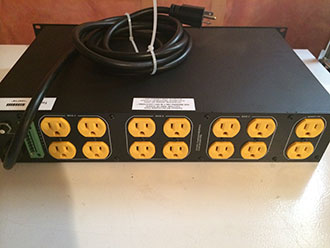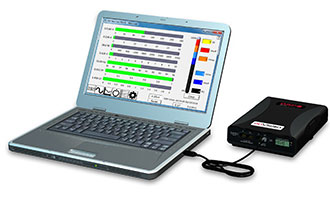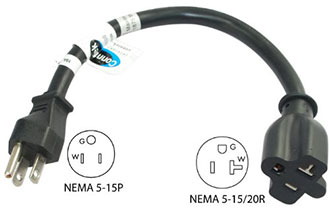A Review of SurgeX SEQ Power Bank and Envision PCS Remote Diagnostic Unit
Serendipity strikes at opportune times.
A couple of months back the eleven year old power conditioner connected to the system in my media room died. Shortly after I had blogged at rAVe about the troubleshooting exercise I treated it as, sharing with readers the apathy of the vendor’s help desk towards such an old product, my friend Nick Brown, also a publicist for SurgeX, reached out to me.
He offered me the opportunity to test and evaluate a couple of their new products, the SurgeX SEQ power bank and the Envision PCS EV-12020 remote diagnostic unit.
 Designated as a programmable, sequenced surge eliminator, the SEQ is a mid-sized power unit (SurgeX also offers models that are much, much larger) which offers programming of sequencing parameters, current conditioning, shutdown thresholds, and surge protection all in one unit. It includes two always-on receptacles and all four banks are programmable, with a total of 14 outlets. Setup and programming of the SEQ is performed via an LCD display on the front panel.
Designated as a programmable, sequenced surge eliminator, the SEQ is a mid-sized power unit (SurgeX also offers models that are much, much larger) which offers programming of sequencing parameters, current conditioning, shutdown thresholds, and surge protection all in one unit. It includes two always-on receptacles and all four banks are programmable, with a total of 14 outlets. Setup and programming of the SEQ is performed via an LCD display on the front panel.
SurgeX’s power conditioning makes use of its Advanced Series Mode surge elimination technology. Dave Perrotta, VP of operations and engineering for SurgeX parent company Electronic Systems Protection, Inc., when I interviewed him for this review, explained, “Advanced Series Mode is superior to conventional MOV circuitry or MOV-Hybrid designs. They completely eliminate surge energy up to 6,000 volts without producing harmful side effects such as ground contamination or common-mode disturbances.” Further elaborating, he says, “Completely non-sacrificial and never needing reset, [the filters in the circuits] provide the most reliable protection available. Our Sequencers also feature both common mode and normal mode impedance tolerant EMI/RFI filtering, ICE (Inrush current elimination), and CouVS (Catastrophic over/under Voltage shutdown) for a complete power conditioning solution.”
Perotta further explained that the advantage of SurgeX’s multi-stage ASM is that unlike MOV surge suppresors, they don’t wear out over time: The level of protection doesn’t degrade over the life of the product. “Major events for the most part aren’t what causes issues,” he said, “It’s the smaller daily events over time. More and more of that energy gets through as the MOVs wear out.” It’s the death-of-a-thousand cuts, and can be the difference between your AV hardware lasting two to three years vs. seven to 10 years or longer.
Beyond surges, the SEQ protects against transients and Common Mode EM and RF noise, both of which are associated with reduced quality of audio and video, as well as playing havoc with microprocessors. Additionally, it protects against over and under voltage events, and is able to sequentially shut down when either over or under voltage persists excessively.
 Designed to work on the front end of SurgeX’s power banks, the Envision PCS from SurgeX’s sister company ESP, is a diagnostic tool that allows integrators to assess the quality of the AC power service going in to their installations.
Designed to work on the front end of SurgeX’s power banks, the Envision PCS from SurgeX’s sister company ESP, is a diagnostic tool that allows integrators to assess the quality of the AC power service going in to their installations.
Incorporating power protection, diagnostic software and real time scope meter capability, the PCS gives service teams the ability to identify power problems quickly and accurately, reducing troubleshooting time and labor costs.
The Envision PCS allows service techs to monitor live electrical incidents, gain enough useful data to reduce “no-problem found” service calls through providing detailed reports to prove electrical anomalies to customers.
That’s a benefit that is not to be underestimated in its utility, as dealing with “gremlins” in the form of electrical anomalies playing havoc with our installed base ten years ago. Having in-depth reporting on the quality and quantity of power service into the building is a huge benefit for AV Pros. If you’ve ever had to argue with the utility company about over/under voltage service issues you know that unless you’ve got hard data to present you won’t get very far with them.
Using the diagnostic software, service techs are able to monitor power disturbances, record events, customize equipment voltage settings, and analyze electrical data via multiple display and communication modules. Even during power outages, the internal battery allows the Envision PCS to continue providing data during power outages (spoiler: data will say “Input Power: ZERO”). Date stamped, and tracked in real time, parameters that are recorded include voltage and amperage, neutral to ground voltage, crest factor, power factor and line frequency metrics.
Events, which are another way to say “crises,” are anomalies that deviate from the normal voltage and amperage that the line connected to the system is supposed to maintain. Events that the Envision PCS is able to identify and report include over/under voltage, surges, outages and shutoffs. Further, the unit is able to identify wiring faults. Data like that is valuable when an AV Pro needs to sit down with both the client and the electrician and prove that the building’s electrical system was wired incorrectly.
Additionally, the Envision PCS incorporates ESP’s Multi-Stage surge and noise protection and includes advanced capabilities such as Cat 6 network protection and ground fault protection.
Installing the SEQ and the Envision PCS was mostly simple: sketching out which source and display devices in my AV system will plug into which outlets in each bank. I did encounter one snag though.
Both the SEQ and the Envision PCS are 20-amp appliances, which means that their power cord terminates in a NEMA 20-amp plug, where the right-hand prong is perpendicular to the left-hand prong. That means that the plug is incompatible with a standard household 15-amp outlet, where the prongs are parallel to one another.
In a new installation, an AV pro would specify a 20-amp breaker and 20-amp outlet for the AC service going to the system. In an existing home like mine however you have to work with what you’ve got. The solution was to order an adaptor from NEMA 15-amp to NEMA 20-amp on Amazon, a $20 fix.
 Now is when I need to point out that plugging a 20-amp power appliance into a 15-amp circuit is NOT recommended by any power management hardware manufacturer.
Now is when I need to point out that plugging a 20-amp power appliance into a 15-amp circuit is NOT recommended by any power management hardware manufacturer.
I am however a trained professional, and when I first installed the AV system in my media room, I added up the total power draw of all of my components, and the system is well under the 1800W maximum of the circuit. With that margin of safety, and knowing that I won’t be drawing on the full capability of the SEQ, I proceeded with the installation.
Unfortunately (or perhaps fortunately, depending on your perspective), in the weeks in which the SEQ and Envision PCS have been servicing my AV system my household has suffered no catastrophic AC events, not even a power outage, which is odd, now that I think about it.
Regardless, the Envision PCS works around the clock, and when you connect to it via a laptop running Envision’s software you have reams of timestamped data to look at. I’ll tell you right now that interpreting power data is not for beginners, nor is the Envision’s software all that intuitive, although the readout will visually highlight when the readings are outside of the normal range. You’re going to have to read the manual and watch their tutorial videos to learn how to interpret what you’re looking at.
It’s not difficult by any means, but like any technical ability, you’re going to have to learn and practice it. Also, the troubleshooting manual will allow techs to correlate the readings presented with the faults associated with those readings.
By now AV pros all know that power hardware that protects AV systems from power problems are mandatory for improving system reliability and client satisfaction. Installing and using SurgeX’s SEQ and the Envision PCS over an extended period of time, I find myself very keen on both the installer friendliness with which the hardware integrates into an AV system, as well as the level of reporting they provide. In a professional setting it’s clear that they give AV pros a major advantage in client care and satisfaction.





